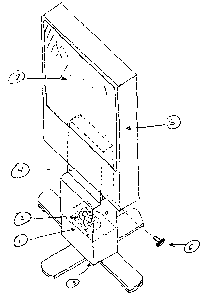Some of the information on this Web page has been provided by external sources. The Government of Canada is not responsible for the accuracy, reliability or currency of the information supplied by external sources. Users wishing to rely upon this information should consult directly with the source of the information. Content provided by external sources is not subject to official languages, privacy and accessibility requirements.
Any discrepancies in the text and image of the Claims and Abstract are due to differing posting times. Text of the Claims and Abstract are posted:
| (12) Patent Application: | (11) CA 2485327 |
|---|---|
| (54) English Title: | PORTABLE BREATHING ZONE AIR CLEANER |
| (54) French Title: | EPURATEUR D'AIR PORTATIF POUR POSTE DE TRAVAIL |
| Status: | Deemed Abandoned and Beyond the Period of Reinstatement - Pending Response to Notice of Disregarded Communication |
| (51) International Patent Classification (IPC): |
|
|---|---|
| (72) Inventors : |
|
| (73) Owners : |
|
| (71) Applicants : |
|
| (74) Agent: | |
| (74) Associate agent: | |
| (45) Issued: | |
| (22) Filed Date: | 2004-11-18 |
| (41) Open to Public Inspection: | 2006-05-18 |
| Availability of licence: | N/A |
| Dedicated to the Public: | N/A |
| (25) Language of filing: | English |
| Patent Cooperation Treaty (PCT): | No |
|---|
| (30) Application Priority Data: | None |
|---|
The objective of this invention is to provide a means of reducing personal
exposure indoors
to certain airborne contaminants including particulates and chemicals
including those
given off or generated by the individual or by his activities and thus avoid
subsequent
symptoms caused by inhaling these materials. The invention is for use indoors
by
individuals with hypersensitivity to certain airborne contaminants. This
invention provides
a solution to the problem of reducing human exposure to suspended particles
and other
airborne contaminants in indoor air that a person breathes. The invention is
an air
filtering/cleaning device that creates a region of slow laminar flow of clean
air in front of
the outlet of the filter, directing clean air to the user's breathing zone.
The filter is for use
by persons in bed or in a sitting location such as a desk or sofa. The slow,
laminar flow
does not cause discomfort to the user and at the same time displaces
contaminated room air
from the user's breathing zone.
Note: Claims are shown in the official language in which they were submitted.
Note: Descriptions are shown in the official language in which they were submitted.

2024-08-01:As part of the Next Generation Patents (NGP) transition, the Canadian Patents Database (CPD) now contains a more detailed Event History, which replicates the Event Log of our new back-office solution.
Please note that "Inactive:" events refers to events no longer in use in our new back-office solution.
For a clearer understanding of the status of the application/patent presented on this page, the site Disclaimer , as well as the definitions for Patent , Event History , Maintenance Fee and Payment History should be consulted.
| Description | Date |
|---|---|
| Time Limit for Reversal Expired | 2009-11-18 |
| Application Not Reinstated by Deadline | 2009-11-18 |
| Inactive: Adhoc Request Documented | 2009-08-20 |
| Deemed Abandoned - Failure to Respond to Maintenance Fee Notice | 2008-11-18 |
| Letter Sent | 2007-02-13 |
| Reinstatement Requirements Deemed Compliant for All Abandonment Reasons | 2007-01-26 |
| Deemed Abandoned - Failure to Respond to Maintenance Fee Notice | 2006-11-20 |
| Application Published (Open to Public Inspection) | 2006-05-18 |
| Inactive: Cover page published | 2006-05-17 |
| Inactive: First IPC assigned | 2005-01-13 |
| Filing Requirements Determined Compliant | 2004-12-14 |
| Application Received - Regular National | 2004-12-14 |
| Inactive: Office letter | 2004-12-14 |
| Inactive: Filing certificate - No RFE (English) | 2004-12-14 |
| Small Entity Declaration Determined Compliant | 2004-11-18 |
| Abandonment Date | Reason | Reinstatement Date |
|---|---|---|
| 2008-11-18 | ||
| 2006-11-20 |
The last payment was received on 2007-10-15
Note : If the full payment has not been received on or before the date indicated, a further fee may be required which may be one of the following
Please refer to the CIPO Patent Fees web page to see all current fee amounts.
| Fee Type | Anniversary Year | Due Date | Paid Date |
|---|---|---|---|
| Application fee - small | 2004-11-18 | ||
| MF (application, 2nd anniv.) - small | 02 | 2006-11-20 | 2007-01-26 |
| Reinstatement | 2007-01-26 | ||
| MF (application, 3rd anniv.) - small | 03 | 2007-11-19 | 2007-10-15 |
Note: Records showing the ownership history in alphabetical order.
| Current Owners on Record |
|---|
| SAUL STRICKER |
| Past Owners on Record |
|---|
| None |